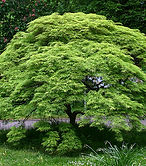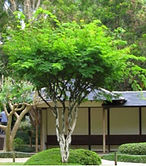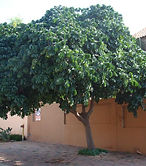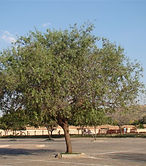The
Tree Store
Sourcing large trees for you...
Trees

Baobab trees / Kremetart (Adansonia digitata)
This tree is found in the dry woodland with mostly drained and rocky soil common in most countries south of the Sahara but in SA limited to Limpopo Province and Mpumalanga. It is a massive deciduous tree that grows up to 20m high with a rounded or spreading crown. The Trunk is firmly cylindrical or pudgy with a max diameter of 12m. The smooth bark is red-brown with many folds. The handshaped leaves are mostly on the tips of the branches. White flowers with waxy petals and numerous meuldrade flower from April to May. The tree is a particularly popular plant in SA for bonsai. Growth rate is moderate and only occur in areas which do not get frost more than once a year.

Black Monkey Thorn / Swartapiesdoring (Acacia burkei)
This tree is found in the south east Zimbabwe, North West, Limpopo, Mpumalanga and northern KwaZulu-Natal. The tree is one of the larger species of acacia and can grow up to 30 m high. This is a deciduous tree with a rounded flat or open crown. The bark often flakes off, spines occur in pairs and are mostly black 3-9mm long. Leaves are 35-70mm long. Flowers are small, sessile & white, with a pinkish to pink-red calyx, flowering from December to May. The pods occur in pendulous clusters of dark purple or reddish brown to 170x24mm. It is also popular among bonsai growers. Moderately aggressive root system but is a very valuable shade tree.

Japanese Maple / Japannese Maple (Acer palmatum)
This is a species of woody plant native to Japan, North Korea, South Korea, China, eastern Mongolia, and southeast Russia. Many different cultivars of this maple have been selected and they are grown worldwide for their attractive leaf shapes and colours. It is a deciduous shrub or small tree reaching heights of 6 to 10 m, rarely 16 metres, often growing as an understory plant in shady woodlands. It may have multiple trunks joining close to the ground. In habit, it is often shaped like a hemisphere (especially when younger) or takes on a dome-like form, especially when mature. The leaves are 4–12 cm long and wide, palmately lobed with five, seven, or nine acutely pointed lobes. The flowers are produced in small cymes, the individual flowers with five red or purple sepals and five whitish petals. The fruit is a pair of winged samaras, each samara 2–3 cm long with a 6–8 mm seed.

Leopard tree / Luiperdboom (Caesalpinia ferrea)
This tree is native of the moist free draining environments, in the tropical regions of Brazil. The Leopard tree is a large tree that can grow up to 20m; it can be pruned at a young age to develop a street tree form. The canopy becomes denser with age and trunk thickens to a very robust size. A Deciduous tree with bright yellow flowers held on the ends of stems, bark is a dappled grey through brown, giving the tree the appearance of a leopard, hence the name. Develop relatively large shiny seed pods. Very hardy tree once established, very deep rooting in well draining soil. This tree will tolerate periods of dryness and light frost. Suited to open area plantings where the magnificence of the tree can be achieved over time.

Marula tree / Maroela (Sclerocarya birrea)
This tree will grow in various types of woodland, on sandy to sandy loam. They occur from Ethiopia in the north to KwaZulu Natal in the south. It is a deciduous tree that can grow to 18m tall. The bark of mature trees is gray and flakes off in patches. Leaves are odd, about 7-13 with some leaves and a single one standing out, crowded near the end of branches, young leaves mostly toothed. Flowers are yellow with a red tint and occur in clusters of 50-80mm long and blooms from September to November. The fruit of the Marula is used in the famous Amarula liqueur. The trees are not cultivated, but the fruits are harvested from wild trees. The fruit has a yellow poles skin, white flesh, rich in vitamin C, and a large stone.

Mountain Karee / Berg Karee (Rhus leptodictya)
This tree occurs in most habitats especially on rocky slopes. They distribute from Angola and Malawi in the north to the Free State in the south. This is a evergreen tree with arching branches and grows up to 8 m tall with a dense crown. Bark of young branches reddish brown, dark brown and rough on older branches and stems. The leaves are sessile leaf 3, the middle leaf is the longest to 95x25mm. Flowers occur in many branched clusters at ends of branches, small and pale yellow flowers blooming from December to April. It is a popular garden plant with a dense roundish crown and contrasting dark brown trunk and can be planted along a fence as an effective hedge or windbreaker.

Mountain Mahogany / Berg Mahonie (Entandrophragma caudatum)
The mountain mahogany grows well in sandy and loamy soils on mountain slopes and rock outcrops. Widely spread in all of Zambia in the north to Mpumalanga in the south. This is a semi-deciduous to deciduous tree that grows to 30m high. The bark of mature trees is thick, gray-brown puff than 100-120mm round pieces and then a mottled appearance. The leaves are up to 250mm long. Fluffy flowers in clusters, individual light green and hairy on the outside that bloom from October to December. They grow banana-shaped fruit to 250x50mm, splits open in five parts. It is an ideal tree for a large garden or park.

Natal Mahogany / Rooi Essenhout (Trichilia emetica)
This tree is found in the coastal forests, riverside forest and riparian forest, rich alluvial land or sandy soil from Sudan in the north to KwaZulu-Natal in the south. The evergreen tree grows up to 20m high with a wide round crown. Bark of young branches is smooth and grayish brown and dark grayish brown on older branches and stems. Leaves up to 500mm long, dark green and shiny on top, covered with short brownish hair at the bottom. Flowers grow in short dense branched heads cream-green and fragrant and measures up to 15mm long, flowering from August to November. The fruit is pear-shaped with s distinct neck up to 30mm long. It is an excellent shade tree for the garden and has a non aggressive root system.

Paperbark / Papierbasdoring (Acacia sieberana)
This tree is found in the forest of KwaZulu-Natal and north of the Vaal River in SA and can reach a height of 18m. This is a semi-deciduous to deciduous tr. The bark is lightbrown or yellowish and often corky or flake off. The straight thorns will grow up to 9cm long. The flowers are small fluffy off-white balls with diameter of 10-12mm that bloom from September to November. The pods are thick, woody and about 15 cm long. The pods will only open after it fell off the tree. The tree provide great shading in grasland for game and livestock and also in a residential garden.

Sausage tree / Worsboom (Kigelia africana)
The tree is found in open woodlands and along river banks. It is common on alluvial soil from Tanzania in the north to KwaZulu-Natal in the south. This is a semi-deciduous to deciduous tree that grows up to 25 m high and has a dense rounded crown. Bark is gray and smooth and flake off slightly older trees. Leaves crowded near tips of branches. Flowers is long loose hanging clusters of 5-12 flowers, calyx tubular and ribbed with 2-5 lobes, petals united, deep velvetred with yellow veins on the outside. The fruit hangs from a fruit stem to 1m long, cylindrical fruit to sausage shaped, gray and rounded at tip and can weigh up to 12kg. With its rapid growth rate, this tree will make a nice shade tree in only 4-5 years. It makes a good bonsai. The roots can be pretty aggressive.

Waterpear / Waterpeer (Syzygium guineense)
This tree usually occurs in lowland forests, in areas close to swamps and sometimes along river banks. They usually grow in moist conditions and sometimes even in water. They also prefer fresh, moist, well-drained soils with a high water table but will also grow in open woodlands. They are widespread from northern KwaZulu-Natal through Swaziland, Mpumalanga, Limpopo to Mozambique, Zimbabwe, northern Botswana and northern Namibia towards central Africa. It is a medium-sized to large evergreen tree and usually grows up to 15–20m high. The bark is smooth and grayish white to grey-brown in young trees, turning rough, flaky, creamy, light grey, dark brown or black in older trees. The leaves are 50–175 mm long and 15–75 mm wide, they are slightly fragrant when crushed. The new foliage is a very attractive purplish- red. It has creamy white flowers about 15 mm in diameter, with a sweet fragrance. They flower from August to December and fruit from December to April. The fruits are usually dark purple when mature with a single rounded seed and are edible.

Weeping Boer-bean / Huilboerboon (Schotia brachypetala)
This tree occurs from Zimbabwe and Mozambique in the north to the East Cape in the south. You will find it mostly in frost-free areas but not limited to any kind of soil. Often on banks of rivers, streams or termite mounds. This is a semi-deciduous to evergreen tree that grows up to 25m high. Bark is gray to reddish brown and rough on older branches and stems. Young leaves are copper colored. Flowers in dense clusters on older branches and older wood that bloom from August to September The fruit is a darkbrown, hard and flat, open-catching pods 5-17x35-47mm long. Ideal tree along a driveway, it is always neat and need little attention. The root system will not cause any damage.

White Karee / Wit Karee (Searsia pendulina)
This is a hardy and very fast growing tree. It is wind and drought resistant and has a pleasing, slightly drooping effect, somewhat similar to a Weeping Willow. It can grow up to 10 m high but usually only reaches 6 to 8m in height, with a spread of about 5mm. In summer it produces sprays of inconspicuous flowers that attract insects. Male and female flowers are on separate trees and the female trees bear bunches of small, round fruits in late summer which are eatenby birds. Edible fruit. It has been widely introduced in SA as a pavement and garden tree, it propagates easily, grows fast and flourishes in full sun. It is not invasive and makes an excellent shade tree. As with most trees they should not be planted very near to paving, swimming pools, pipes or walls, as their fast growth may quickly affect these. They however have a non-aggressive root system.

White Stinkwood / Witstinkhout (Celtis Afrikana)
This is a common tree that occurs widespread on the Highveld. It is drought resistant and grows quickly. The tree has small, pale yellow flowers that bloom from August to October. The tree not only provides shelter for livestock, but birds and animals also eat the fruit that it produses from October to February. It also makes a good shade tree in a garden and need full sun and moderate water. The leaves are three-queasy from an asymmetrical base and the edges of the upper half or two-thirds of the leaves are coarsely serrate although it sometimes can be untoothed.

Wild Olive (Olienhout)
An evergreen tree that grows up to 14m high. Bark is gray-brown, rough and flaking off on older branches and stems. Widespread in Africa, the Maskerene, Arabia, India and China. Grow in almost any habitat, especially in woodland, beside streams and on rocky slopes. Individual flowers are creamy white 6-10mm long with a sweet smell to it. The fruit is a stone fruit with thin pulp 10mm long, black when ripe. The neat crown, evergreen leaves and the fact that it responds well to pruning, makes it an ideal garden and street tree. The roots are sometimes aggressive. It is a popular bonsai plant.
***All images on this page illustrate a fully grown specimen and NOT the actual size we sell***